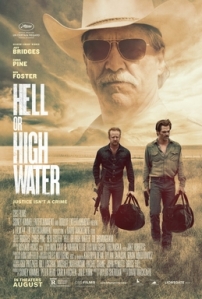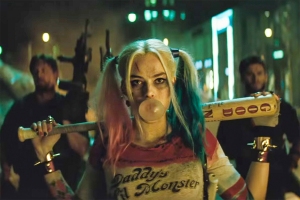 Dancing between the raindrops. One of the most powerful and essential things that film can do, arguably unlike any other medium, is to transform the smallest moments of daily life into something poetic, allegorical, epic, and identifiable. Film, at its best, is a concise narrative, simultaneously immediate and retrospective, exploring an embedded assumption that one exchange, one decision, one day can change a lifetime.
Dancing between the raindrops. One of the most powerful and essential things that film can do, arguably unlike any other medium, is to transform the smallest moments of daily life into something poetic, allegorical, epic, and identifiable. Film, at its best, is a concise narrative, simultaneously immediate and retrospective, exploring an embedded assumption that one exchange, one decision, one day can change a lifetime.
Two movie gems, exemplifying this remarkable storytelling attribute, are currently eking out a quiet subsistence in a far corner of your local multiplex. Stroll past the escapist CGI gargoyles, laser blasts, and gross out gags of those late summer wannabe blockbusters taking up the IMAX screens, and make your way to that tiny, itty bitty screening room. You know the one, beyond the garish birthday hall, clanging arcade, and Dippin’ Dots (“Ice Cream of the Future!”) outpost, at the far end of the hall … the one that seems like its sole existence is as a concession to the public television/NPR crowd or because an extra broom closet wasn’t needed? And catch Hell or High Water and Southside with You on the big-ish screen before they are consigned to Netflix next month.
Hell or High Water is as perfect a Valentine to people who love movies as I’ve ever seen. It wears its cinematic influences proudly and confidently, like that person in your office who has figured out how to mix stripes, plaids, and polka dots into a breathtaking ensemble. Director David Mackenzie (Young Adam) mines A Touch of Evil (the tracking shot that opens Hell or High Water is a smooth, small-town honey), No Country for Old Men (dusty postmodern desperation), Giant (watch Hell or High Water‘s final front-porch confrontation and tell me I’m wrong), East of Eden (imagine Cal and Aron as kinder, gentler, floppy-haired Natural Born Killers), and Dog Day Afternoon (shaggy, sweaty bank robbers who have Robin Hood-aspirations to right the personal wrongs that corporate America has inflicted and who are destined to fail … spectacularly). Throw in one of the best depictions of Dust Bowl brotherly love/hate since Sam Shepherd’s classic play True West and pair it with the corrosive antipathy toward American Big Banking and the mortgage industry that The Big Short failed to capture compellingly, and you have a film for the ages.
Star Trek‘s Chris Pine (all dreamy, haunted dissipation) and 3:10 to Yuma‘s Ben Foster (Sean Penn 2.0 … damn, but he is SO good, and Foster even was engaged to Robin Wright Penn – twice – after she divorced Sean) play Toby and Tanner Howard, locked in a toxic cycle of arrested development, one a loyal son but failed husband and the other a loyal brother but ne’er-do-well prodigal. Toby has cared for their dying mother and stands to inherit the dilapidated family homestead (with its recently discovered oil reserves) if he can climb out from under the crushing reverse mortgage that mama foolishly, but necessarily, took out and which is now careening toward foreclosure. Tanner, whose lengthy prison record includes time for bank robbery but surprisingly not for murdering their abusive father, is the anarchic muscle, a Looney Tune with nothing to lose who helps support the otherwise straight-arrow Toby’s scheme. Their plan? Swipe just enough cash from the teller drawers of that very predatory lending bank holding the deed to the family home, pay said bank back the money, secure the land and the oil rights, and leave it all in trust to Toby’s two sons. It’s like the perfect Playhouse 90 – on steroids.
Oh, and the whole enterprise is set among the Great Recession-scorched badlands of Western Texas, where the endless dirty, rusty miles between neon-lit casinos are dotted with billboards touting “Instant, Easy Debt Relief” like Faustian blood-pacts with the financially damned. The long (and folksy) arm of the law is ably represented by True Grit’s Jeff Bridges (absolute mumble-mouthed perfection as Marcus Hamilton, a Texas Ranger who views his impending retirement as more of a death sentence than an earthly reward) and Twilight‘s Gil Birmingham (as Alberto Parker – comically poignant gold, playing the stoic straight man, enduring a steady stream of Marcus’ jabs, zingers which shock for being as loving as they are racist).
The film is picaresque, taking place over the course of just a few days. And it is a beauty, well-acted and crafted with such thoughtful precision that it stuns in its quiet verisimilitude. It is an indictment and celebration of the day-to-day crushing dreariness of American life – divorce, mortgages, child care, jobs, ambition, law and order, vanquished dreams – depicting a society that by dint of its unintentionally intentional design oppresses the brightest of hearts, turning mere survival into insurmountable distress. And don’t get me wrong, the movie is still an entertainment of the highest order, bleak but funny and engaging as hell.
![[Image Source: Wikipedia]](https://reelroyreviews.files.wordpress.com/2016/08/southsidewithyoupromotionalposter.jpg?w=202&h=300)
[Image Source: Wikipedia]
Zero Dark Thirty‘s Parker Sawyers (a fellow Wabash College graduate, though our time in those hallowed halls, alas, did not overlap) and Sparkle‘s Tika Sumpter (also acting as a producer on the film) are luminous as the eventual First Couple: Barack Obama and Michelle Robinson. Director Richard Tanne grounds the proceedings in a lush but gritty depiction of the scruffy joys of Chicago-life, and his two leads reward him (and the audience) beautifully. They are so good, subtly evoking mannerisms and vocal stylings, without ever resorting to caricature.
The film opens as these two prepare for the date – Michelle in denial (sort of) that it actually is a date – interacting sweetly with family members, electric in their nervous anticipation of the day before them. There is a gangly charm to these early scenes, humanizing two historical figures whose global accomplishments may have placed them in that unreachable classification: icon. It’s a smart narrative move for all involved.
As the film progresses, we learn that Barack is a summer associate at Michelle’s firm, and she has been assigned as his mentor. Set in the summer of 1989 (and, wow, does Tanne get that right from the fashion and the set direction to the cars and the music, including vintage Janet Jackson and Al B. Sure! playing on the radio), Michelle is cautious about the challenges facing her as a woman of color in a white man’s world, and she will be damned if this upstart intern is going to derail her career with his romantic overtures. He, on the other hand, is as earnest as he is charming, and it is evident that the engagement of each others’ impressive intellectual capacity – their beautiful minds – is how this romance blossomed and flourished.
Southside with You mostly sidesteps the pitfalls of movie biography (the pressing need to tell a whole lot in two short hours) by focusing on just this one day. Given that the narrative hook is a date, the characters have the latitude to ask a lot of questions as they get to know one another, and, by extension, we, as audience members, catch up on essential biographical detail and helpful context. Ninety-five percent of the time this works beautifully, aided and abetted by the naturalness of the performers, but a few moments are jarringly expository (particularly the discussion in the park about Barack’s upbringing) and make Southside with You feel like more of a stage play than a film. Nonetheless, those flaws are few and far between, and as the film moves toward the inevitability of its conclusion, we as viewers are gifted with consummate appreciation for the challenges this partnership overcame – culture, economics, race, gender – to step onto the global stage and effect needed social change.
Early in their date, Michelle and Barack debate the merits and downsides of working in a corporate law firm when there is so much need outside the business world for legal minds to provide community leadership: “There’s no contribution at our level. Just the illusion of contribution.” It is this existential riddle that drives both Hell or High Water and Southside with You, and, whether you are two down-on-your-luck siblings weighing a life of crime just to pay your mortgage, two lawmen putting in a brutal day’s work and hoping you emerge unscathed, the future First Couple of the United States mapping out a future together, or just some lowly audience member chomping popcorn in the movie theatre, that resonates.
_________________________________
![[Image Source: Wikipedia]](https://reelroyreviews.files.wordpress.com/2016/08/800px-barack_and_michelle_obama_at_the_home_states_ball.jpg?w=285&h=300)
[Image Source: Wikipedia]

![[Image Source: WIkipedia]](https://reelroyreviews.files.wordpress.com/2016/08/petes-dragon-poster.jpg?w=203&h=300)
![[Image Source: Wikipedia]](https://reelroyreviews.files.wordpress.com/2016/08/florence-foster-jenkins.jpg?w=205&h=300)






![[Image Source: Wikipedia]](https://reelroyreviews.files.wordpress.com/2016/08/ghostbusters-2016.jpg?w=300&h=169)
 I daresay we see too many Zac Efron movies in our household (evidence
I daresay we see too many Zac Efron movies in our household (evidence  Reel Roy Reviews is now TWO books! You can purchase your copies by clicking
Reel Roy Reviews is now TWO books! You can purchase your copies by clicking